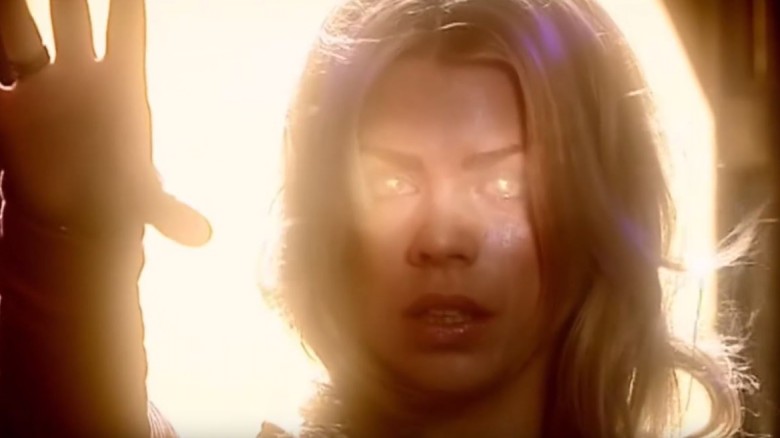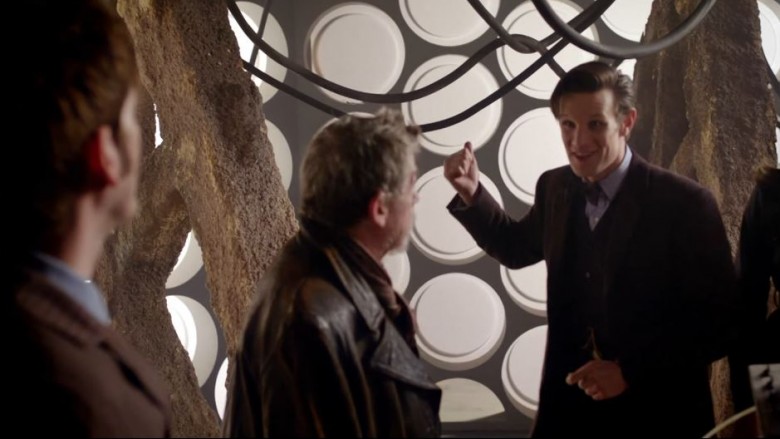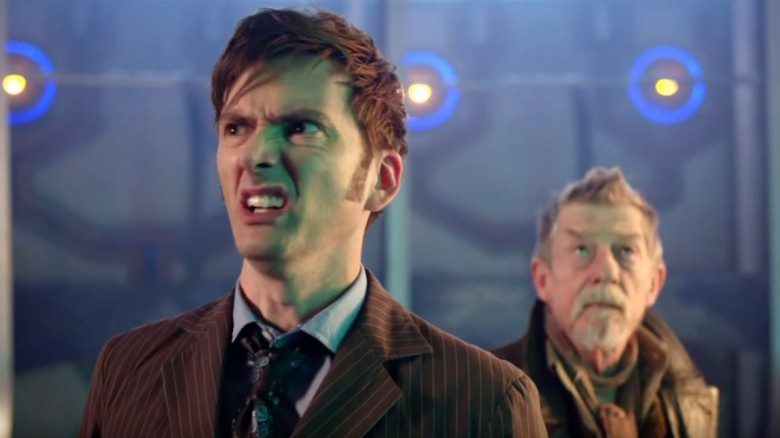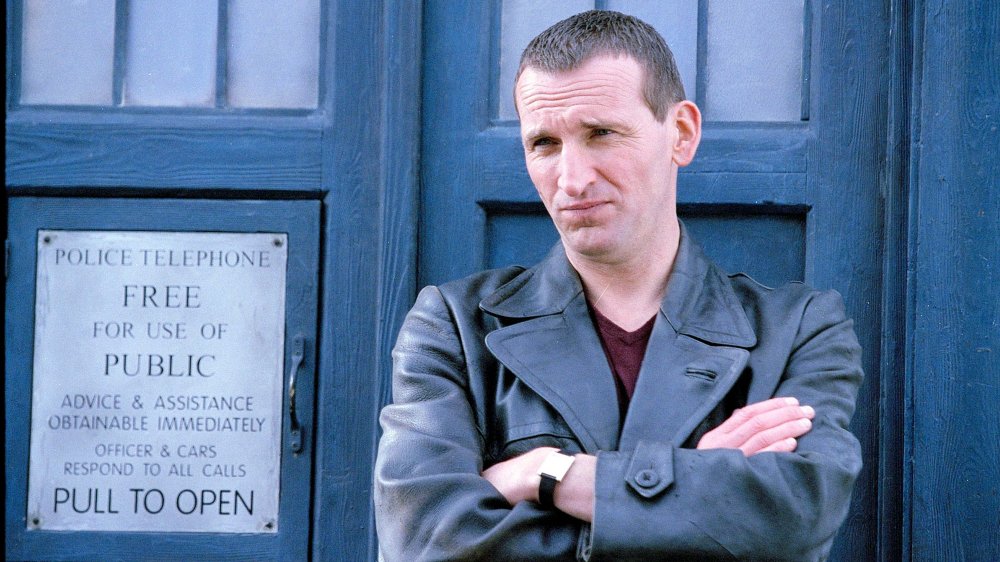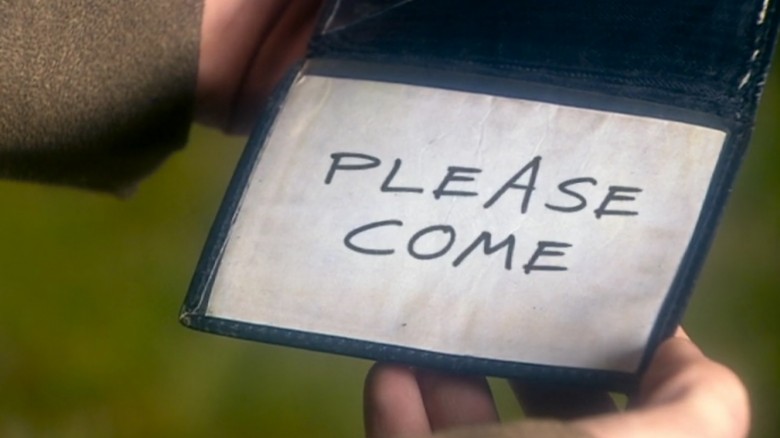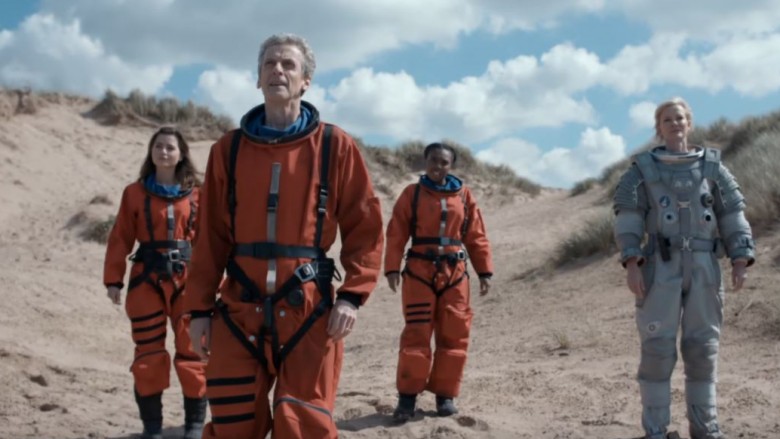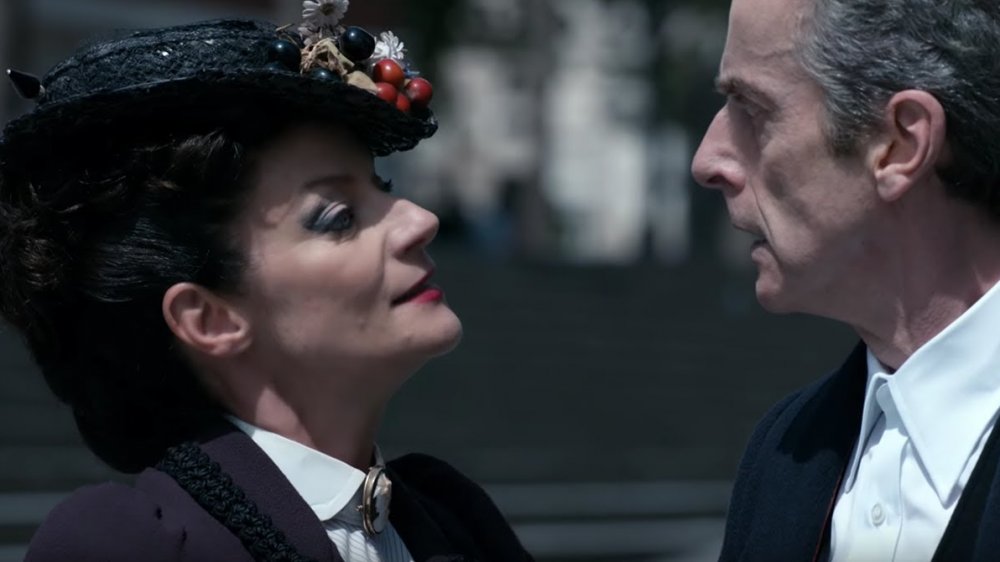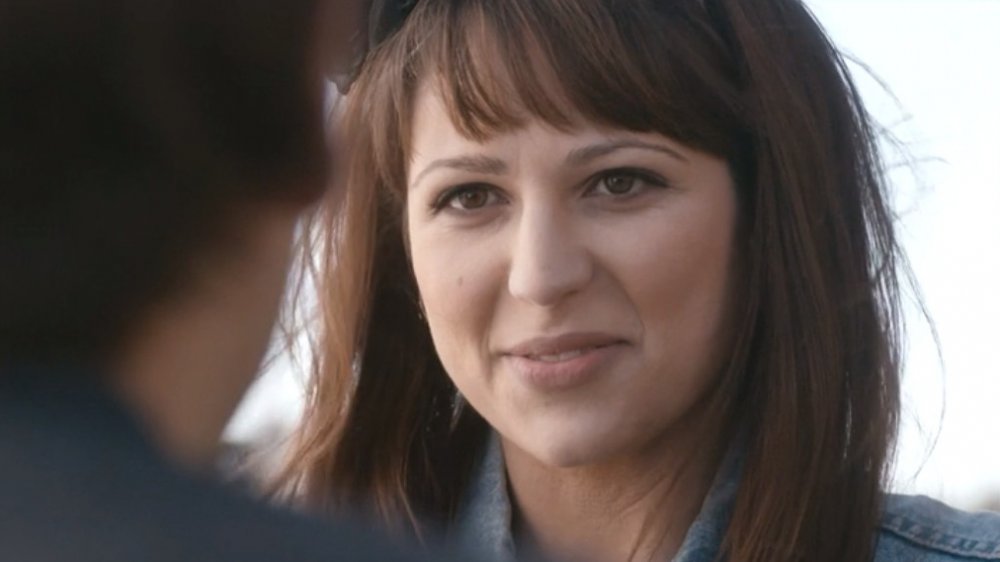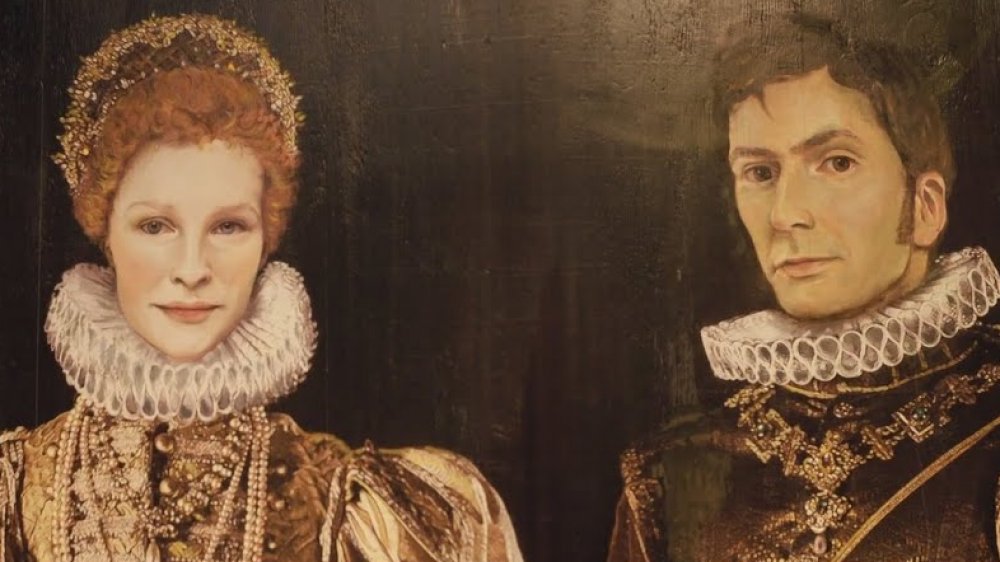Small Details In Doctor Who Only True Fans Understood
Since its debut in 1963, Doctor Who has been a cultural institution in the U.K., and among the most influential science-fiction franchises anywhere. The often dense and charmingly low-budget series built up a cult following in the U.S. in the '70s and '80s, thanks in large part to airings on public television stations, as well as the winning performance of Tom Baker as the fourth incarnation of the titular Doctor, an old, wise, heroic alien who traveled through space and time with the aid of his TARDIS, a complicated bit of machinery disguised as an English police box. After the show first ended in 1989, the BBC launched a stylish and lavish reboot of the series in 2005, making stars out of Doctor portrayers like David Tennant, Matt Smith, and Jodie Whittaker while also attracting millions more fans around the world to the Who-niverse.
Doctor Who's long, rich history may seem daunting to beginners, but before you can say "Allons-y" or "Geronimo" to the mad man with a box, here are a few small details only the most dedicated Whovians would catch.
Bad Wolf
Doctor Who's lengthy first run ended in 1989, and while an attempt was made to resuscitate the series in 1996, it wasn't until 2005 that it finally returned under the leadership of executive producer Russell T. Davies. The first season of the revival focused mainly on introducing the ninth iteration of the Doctor (Christopher Eccleston) and his familiar foes like the Daleks, but also added fan favorite companion Rose (Billie Piper)—and a new season-long mystery.
Rose's adventures on the TARDIS took her to many far-flung locations, but everywhere she and the Ninth Doctor went, the words "Bad Wolf" always seemed to follow. Boyfriend Mickey (Noel Clarke) owned a video game with the same name. A little boy painted the words on the side of the TARDIS in the episode "Aliens of London." There's the Bad Wolf Corporation in "Bad Wolf" and Bad Wolf TV in "The Long Game." Finally, in the season one finale "The Parting of the Ways," it's revealed that the "Bad Wolf" is Rose herself. Having looked into the heart of the TARDIS, she absorbed its energy, destroyed the Daleks, and scattered the words "Bad Wolf" throughout the universe as clues to help direct her to that moment. Unfortunately, the Ninth Doctor was forced to absorb her energy into himself to save her, causing him to regenerate into the Tenth Doctor (David Tennant).
Other subtle "Bad Wolf" references popped up during season two in episodes like "Tooth & Claw" and "Love & Monsters." During what many fans consider the most heartbreaking moment in the show's history, the Doctor and Rose say a tearful goodbye in Darlig Ulv Stranden, a.k.a. Bad Wolf Bay, in the episode "Doomsday."
The "Bad Wolf" subtly reappeared in clues throughout season four as well, as when Rose showed up for the season finale, "Journey's End." For the 50th anniversary episode "The Day of the Doctor," the Moment takes the form of Rose as the "Bad Wolf," interacting with John Hurt's War Doctor. It's a nice "moment," all puns intended, that brings the series full circle all the way back to season one of NuWho.
The 'round things'
The Doctor just wouldn't be the Doctor without his trusty "sexy" blue police box, the TARDIS, or Time And Relative Dimension In Space. It has the ability to travel anywhere in time or space and can blend into its surroundings using a chameleon circuit; however, the circuit broke on the Doctor's, leaving it forever fixed in the shape of a blue police box, making it an iconic image for both the show and its characters. While the outside of the TARDIS may appear unassuming, the inside, like its owner, is always changing its appearance.
But there's one design feature that always stays the same throughout every regeneration: the "round things," which are actually called roundels, are typically either circular or hexagonal in shape, and line the walls of the console room. While they generally function as a decorative element, sometimes they've been used for more functional purposes. One was used as a scanner during the season five episode "The Beast Below," and in "The Husbands of River Song," one was used to store liquor inside the Twelfth Doctor's TARDIS (much to his surprise). During "The Day of the Doctor," the Tenth, Eleventh, and War Doctor expressed their love for the TARDIS' roundels, but for being such highly intelligent aliens, they sure were dumb about one of the most basic design features of their chosen home. Mad men with a box indeed.
You've redecorated. I don't like it.
"It's bigger on the inside," most companions exclaim when they first walk inside the TARDIS doors, and that's true thanks to an effect called dimensional transcendentalism — the interior literally exists in a different dimension than the exterior due to transdimensional engineering. In fact, the TARDIS contains innumerable rooms, including a library and even a swimming pool. The main console room, which contains the control panel, usually undergoes the most physical changes during the Doctor's regeneration, but since the TARDIS is partially sentient, it can also change itself by choice.
The Doctor can also redesign certain elements of the interior or change "the desktop theme." The Eleventh Doctor completely redesigned his console room between the sixth and seventh season. And the Twelfth Doctor made slight modifications during the eighth season because, as he put it, "I think there should be more round things on the walls. I used to have a lot of round things."
These modifications have prompted other incarnations of the Doctor and even other characters to pronounce, "You've redecorated. I don't like it." The line has become a long-running joke on the show since the Second Doctor (Patrick Troughton) first uttered it to the Third Doctor (Jon Pertwee) during the very first episode to feature multiple Doctors, the fittingly titled "The Three Doctors." Occasionally it's been heard in other situations, like when Eleven visited old roommate Craig in "Closing Time," but mostly it's used whenever the Doctor meets other regenerations of himself. Considering how picky the Doctor is about his food tastes, it's not surprising his decorating demands fall under the same level of scrutiny.
Doctor who? John Smith is who
The question is literally in the title: Doctor who? The Doctor's real name is one of the oldest mysteries on the show, and has been an oft-discussed topic among various characters over the years. Much of the revival's messy seventh season grapples with the Doctor's true identity, including the aptly titled season finale, "The Name of the Doctor." (Spoiler: you never learn what it is.) River Song (Alex Kingston) apparently knew the Doctor's real name, having whispered it in the Tenth Doctor's (David Tennant) ear in the Library during the fourth-season two-parter, "Silence in the Library/Forest of the Dead." She also silently transmitted it to the TARDIS on Trenzalore in order to open the doors for the Great Intelligence during "The Name of the Doctor."
While "The Doctor" is an alias itself, he often uses other names during his adventures to conceal his identity. One of his oldest and favorite aliases is John Smith, which he has used frequently during visits to Earth going all the way back to William Hartnell's First Doctor in 1963. "John Smith" has made many appearances during NuWho, like when the Ninth Doctor (Christopher Eccleston) called himself "Dr. John Smith" during a visit to London in 1941 during "The Empty Child" in season one, or when the Eleventh Doctor (Matt Smith) tried to infiltrate Sweetville in "The Crimson Horror" during season seven.
But no Doctor used the "John Smith" alias more frequently than David Tennant's Tenth Doctor. He most famously lived as human teacher John Smith at Farringham School for Boys in 1913 during the episode "Human Nature." The Doctor used the chameleon arch to rewrite his biology to become human, concealing his true Time Lord self inside a fob watch, which he gave to companion Martha (Freema Agyeman) for safekeeping from alien pursuers. Human "John Smith" wound up falling in love with school nurse Joan Redfern, but sadly, he had to transform back into the Doctor in order to save her and the rest of the school.
Psychic Paper
Along with his many aliases, the Doctor has also often relied on his psychic paper to get him out of many sticky situations. Kept in a wallet, it's a blank white sheet that can be filled with the user's mental projections to fool those who look at it. Like Jedi Mind tricks, it only works on the weak-minded, which is why (much to the Doctor's amazement) it didn't work on Shakespeare in the season three episode "The Shakespeare Code." It also occasionally doesn't work on some alien species, like the Saturnynians in "The Vampires of Venice."
The Doctor isn't the only one who's used the psychic paper. Rose tried it on Jack Harkness in "The Empty Child" with fairly embarrassing results, letting the handsome time agent know she had a boyfriend but considered herself "very available." Courtney Woods used it to go shopping and as a fake ID to go to clubs in "Kill the Moon." Clara tried to use it on Rigsy (Joivan Wade) in "Flatline" while the Doctor was stuck in a rapidly shrinking TARDIS, but all he saw was blank paper.
The psychic paper can also receive messages from those who have psychic abilities or a connection to the Doctor, like UNIT. Typically, these messages are some kind of distress call, such as when Eleven was contacted by the Tenza child George in "Night Terrors," or when River Song asked the Tenth Doctor for help in the Library in "Silence in the Library." The Face of Boe asked the Doctor to "please come" to New New York in "New Earth." Occasionally these messages are warnings, such as when the Atraxi contacted Eleven about Prisoner Zero's escape in "The Eleventh Hour." Think of it like Time Lord texting.
Bananas
Turns out our favorite Time Lord is pretty bananas for bananas. Though occasionally his tastes have changed depending on the regeneration (see the Eleventh Doctor's search for food with Amelia Pond in "The Eleventh Hour"), it seems like his love for the Earth fruit has remained constant throughout his very long life. After all, it's a "good source of potassium."
The Third Doctor (John Pertwee) and companion Jo Grant gave a banana to a captive in the episode "Frontier in Space," who ate it skin and all. The Sixth Doctor (Colin Baker) found a banana in his pocket and gave it to Peri in "The Two Doctors," but she saw a dead Androgum and lost her appetite. During "The Doctor Dances," the Ninth Doctor (Christopher Eccleston) told companion Rose (Billie Piper) how much he loved bananas and swapped Jack Harkness' (John Barrowman) gun for one to prevent him from shooting a child. The Eleventh Doctor (Matt Smith) played the same trick on River Song (Alex Kingston) so she couldn't kill him in "Let's Kill Hitler" during season six. And Twelve's frenemy, Missy (Michelle Gomez), has frequently referred to herself as "bananas."
But it was Ten (David Tennant) who showed the most love for the yellow fruit. In one of Who's creepiest episodes, season four's "Midnight," Ten tried to stop the possessed Sky from copying him by mentioning something about bananas. We might also have to thank the Tenth Doctor for inventing the banana daiquiri all the way back in 18th century France when he romanced Madame de Pompadour in "The Girl in the Fireplace." At one point he also told Rose, "Always take a banana to a party, Rose. Bananas are good." Who are we to argue? Always do what the Doctor orders.
The orange spacesuit
"Oi! Watch it, spaceman!" Companion Donna Noble (Catherine Tate) was fairly fond of referring to the Tenth Doctor by this nickname, because he was, after all, capable of traveling anywhere in time and space. And even though he has two hearts and a special respiratory bypass system, the Doctor sometimes needs to wear a protective spacesuit on his adventures on alien worlds. Thankfully, he always keeps an orange one or three on board the TARDIS for any close encounters of the third kind.
The Doctor first acquired his signature orange spacesuit in "The Impossible Planet" in season two, as he traveled from the surface base of Sanctuary 6 down towards the core of planet Krop Tor. Safely back aboard the TARDIS at the conclusion of the second part, "The Satan Pit," the suit found a permanent home and owner. The Tenth Doctor donned it again for "The Waters of Mars," but he damaged the helmet while trying to defeat zombie-like water aliens.
The suit's next appearance wasn't until "Hide," when Clara told the Eleventh Doctor the color hurt her eyes, much to his disappointment. But she seemed to get over it: she wore it at least twice during her travels with the Twelfth Doctor, in both "Kill the Moon" and "The Girl Who Died." Here's hoping we haven't seen the last of it.
The Master is Missy
The Doctor may be over 2,000 years old, but it took until 2018 — 55 years after Doctor Who premiered — for the Time Lord to take on a female form. Jodie Whittaker joined the series as the Thirteenth Doctor, right when Chris Chibnall took over as showrunner from longtime Who helmer Steven Moffat. According to Chibnall, he never planned on casting anyone but a woman, while Moffat faced criticism for the show's treatment of female characters and lack of a female lead. But Moffat may have been working for quite a while on getting longtime Who viewers used to the idea of a woman in the title role.
The character of Missy (Michelle Gomez) was introduced in 2014 as a merely kooky and cutthroat villain... until she revealed her true identity to the Twelfth Doctor (Peter Capaldi). It would seem "Missy" is short for "Mistress," the female form of "Master" — as in The Master, the Doctor's most challenging nemesis. The last time the Master had appeared was in a 2009-10 arc, and was presumed killed in a fight with a Time Lord named Rassilon (Timothy Dalton). Fans were surprised when the character was shown to be not only alive, but also a woman. But in the 2015 episode "The Magician's Apprentice," Missy confided to companion Clara (Jenna Coleman) that she'd known the Doctor "since he was a little girl," suggesting the Doctor was once a woman, and could be again.
The importance of March 5, 2005
"The Rings of Akhaten" from 2013 represents Jenna Coleman's fourth episode of Doctor Who overall, so audiences were still getting to know her character when the show started to fill in the gaps in her backstory. More information is learned about this companion, this mysterious "Impossible Girl," a young teacher named Clara Oswald. Her mother died when she was a child, and the episode depicts Clara visiting her the gravesite of her departed mum, Ellie. The elder Oswald's death date, per her headstone: March 5, 2005. That date is significant to Doctor Who fans for a couple of reasons. First: The revival of the series, starring Christopher Eccleston and Billie Piper as Time Lord and companion, respectively, hit the airwaves in March 2005. Second: The specific date of March 5, 2005 is the day in that first episode, "Rose," when Earth was invaded by Autons, and when the Doctor met Rose. That makes it a significant day in the lives of two Who companions, particularly for Clara, whose mother, it's highly suggested, died during that Auton onslaught.
The Doctor and the Queen's relationship: It's complicated
As he can travel through time as well as space, the Doctor has met many historical figures, such as Charles Dickens, Richard Nixon, Vincent Van Gogh, and, memorably and frequently, Queen Elizabeth I, who sat on the English throne from 1558 to 1603.
Her Majesty is something of a recurring character on Doctor Who, first appearing in the 1965 episode "The Chase," when companion Barbara (Jacqueline Hill) asks to travel to the Elizabethan Era, where she witnesses the Queen chatting with Shakespeare. The monarch makes a big comeback — as the subject of a slowly unfolding, time-hopping running joke in the 2007 episode "The Shakespeare Code," The Elizabethan-set adventure ends with a guard ordering the Doctor to "Stop in the name of the Queen!" The Doctor (David Tennant) doesn't know what he did wrong because he hasn't "even met her yet." Flash forward to Tennant's last original appearance as the Time Lord in the 2009 Christmas special "The End of Time." The Doctor mentions that during his time away, he married "Good Queen Bess" and that her nickname "The Virgin Queen" is no longer apt. They touch base again, wrapping up the arc in the 2013 special "The Day of the Doctor."
Education is very important on Doctor Who
A quaint educational facility called Coal Hill Secondary School figures prominently during the Clara years of Doctor Who. In the 50th anniversary special "The Day of the Doctor," there's a brief stop at the institution, and Clara rides the Doctor's motorcycle out of there. Later on, Clara and love interest Danny Pink (Samuel Anderson) are depicted in their daily lives as instructors at Coal Hill, which is also the setting for the short-lived 2016 spinoff series Class. This isn't some random school with which modern-day Who writers are obsessed — it's part of the show's extensive continuity, and it goes all the way back to "An Unearthly Child," episode number one of the original series, way back in 1963.
William Hartnell's Doctor had a quirky grandchild named Susan. Young Susan (Carole Ann Ford) attended Coal Hill School, and since she apparently lived in an old blue police box (a.k.a. the TARDIS), she aroused the curiosity of two teachers there: Ian Chesteton (William Russell) and Barbara Wright (Jacqueline Hill). Ian and Barbara got to be TARDIS-borne companions, just like their Coal Hill successor Clara. And some of them are probably even acquainted. Coal Hill's sign lists an "I. Chesterton" as its chairman of the governors. (The headmaster of the school: someone named "W. Coburn." That's certainly a reference to 1963-era Doctor Who writer Anthony Coburn.)

